|
Listen to post:
Getting your Trinity Audio player ready...
|
Executive Summary
To further raise awareness on threat actor activity in the dark web and hacking communities, today we are introducing the Cato CTRL Threat Actor Profile. This will be a blog series that profiles various threat actors and documents notable activity that we are observing. Our inaugural Cato CTRL Threat Actor Profile is on Yashechka.
Yashechka is a Russian threat actor, who is a highly active participant across various underground hacking forums focused on data breaches, malware development and the exploitation of software vulnerabilities.
Yashechka’s activities range from sharing malware source code to in-depth discussions and contributions on methods to bypass or exploit Endpoint Detection and Response (EDR) solutions. Yashechka has substantial technical expertise and access to a variety of cybercriminal tools and techniques, as evidenced by his detailed forum discussions.
Below is an overview of Yashechka’s activities:
- Malware Development and Sharing:
- Yashechka specializes in the development and dissemination of ransomware and information stealers, focusing on financial gain and data exfiltration of targeted systems.
- Yashechka provides detailed guidance, including source code for building and customizing malicious software, and demonstrates a high level of proficiency in programming and malware creation.
- Exploitation of System Vulnerabilities:
- Yashechka regularly shares techniques for exploiting CVEs (Common Vulnerabilities and Exposures), particularly within Windows environments.
- Yashechka has shown a vested interest in bypassing EDR solutions.
- Community Engagement and Influence:
- Yashechka regularly engages with other cybercriminals through tutorials, advice and collaborative projects, extending his impact to influence entire communities of entrepreneurial threat actors.
- Use of Anonymization Techniques:
- Yashechka demonstrates his expertise in operational security by using anonymization techniques and encouraging other threat actors to leverage tools and methods to evade detection.
Yashechka represents a high level of threat due to his technical skills, active involvement in the cybercriminal community and focus on disseminating harmful information and tools. His activities are likely to support and enhance cybercriminal operations (both individually and at a community level), which poses a direct threat to organizations.
Q2 2024 Cato CTRL SASE Threat Report | Get the reportTechnical Overview
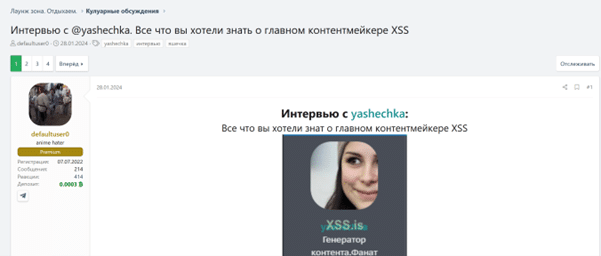
Figure 1. XSS forum post of Yashechka interview
Yashechka is active on XSS, a Russian dark web forum. This interview with Yashechka provides insights into his background, personal experiences and perspective on InfoSec. Here’s an analysis of key parts of the interview:
Background and Personal History
- Childhood and Accidents: Yashechka shared anecdotes from his childhood growing up in the 90s, including a near-death experience which appears to have shaped his outlook and perhaps his future interest in InfoSec.
- Initial Interest in InfoSec: His interest in InfoSec began in January 2003, notably after another life-threatening incident as an adult, which further intensified his focus on the field.
Technical Involvement and Expertise
- First Computer and Access to Internet: Yashechka discusses his first experiences with computers and internet access, dating back to 2000. This marks the beginning of his deeper involvement with technology.
- Content Creation: Yashechka is known for his educational YouTube videos (especially tutorials and translations), indicating a strong commitment to sharing knowledge and assisting others in the InfoSec community.
- Dark Web Forum Participation: Yashechka mentions his active participation in dark web forums such as Antichat, Exploit.in and XSS, where he engages deeply with the community.
Perspective on InfoSec
- Ethical Stance: Yashechka reflects on the ethical dimensions of hacking, suggesting a preference for educational and protective measures in cybersecurity rather than engaging in malicious activities.
- Professional Experience: Yashechka’s professional background includes various roles which, while not exclusively focused on cybersecurity, involve significant technical expertise.
Health Issues and Personal Struggles
- Health and Wellness: Yashechka openly discusses his health challenges, which affect his day-to-day life and professional activities. His condition influences his work style and his contributions to the field.
Threat Analysis and Capabilities
- Skill Set: Yashechka is highly knowledgeable in InfoSec. The interview revealed that his key focus is on educating others.
###
Below are several examples of posts from Yashechka in XSS that would be deemed malicious.

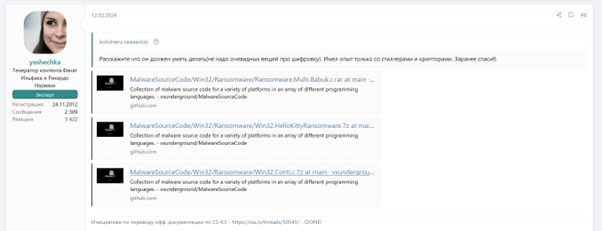
Figure 2. Yashechka post: How to write an encryptor?
Explanation of malicious intent:
- Promotion of Malware Development: Yashechka provides links to repositories that contain source code for ransomware. This encourages and facilitates the creation and distribution of malware. Sharing malware source code can help others learn how to build and possibly deploy ransomware, which is highly illegal and potentially catastrophic for organizations.
- Encouragement of Illegal Activities: By directing the original poster and others to sources where they can find detailed malware code, Yashechka is promoting illegal activities. Developing, distributing or using ransomware to attack systems and encrypt data for ransom is a criminal act in many jurisdictions.
- Potential Damage: The spread of ransomware has significant repercussions. It can lead to financial losses, operational downtime, reputational damage and the loss of sensitive data. Encouraging the creation of such tools contributes to cybercrime.
- Ethical Concerns: From an ethical standpoint, providing resources and knowledge on how to engage in cyberattacks lowers the ethical standards within the cybersecurity tech community.
It’s evident based on Yashechka’s response that he poses a significant threat to organizations and systems. His proficiency in malware types makes him a legitimate threat to organizations that could potentially become targets of an attack.
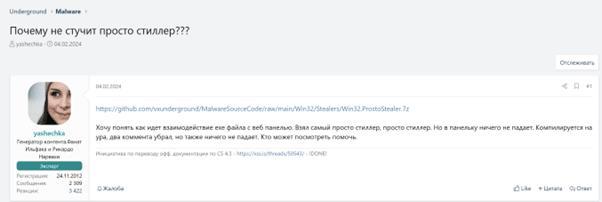
Figure 3. Yashechka post: Why doesn’t the simple stealer report data?
Explanation of malicious intent:
- Distribution of Malware Source Code: Yashechka includes a link to download a “simple stealer” from a known repository of malware source code. Information stealers are a type of malware designed to harvest sensitive data such as passwords, credit card details and other personal information from infected systems.
- Technical Support for Malware Deployment: Yashechka is seeking assistance to make the malware operational, specifically wanting to understand why the data harvested by the malware isn’t appearing in the control panel. This suggests an attempt to activate and possibly deploy the information stealer malware.
- Promotion of Malicious Activities: By asking for assistance in troubleshooting malware, Yashechka is encouraging others to engage in malicious activities.
- Ethical and Legal Implications: Discussing and sharing methods for the effective deployment of malware violates ethical standards, in addition to legal regulations against the creation and distribution of malicious software.
The nature of this post highlights clear intention towards developing and utilizing tools that are inherently designed to perform unauthorized extraction of data, thus posing a significant threat to digital safety and privacy.
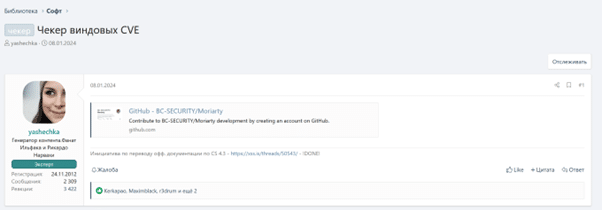
Figure 4. Yashechka post: The use of a Windows CVE checker
The post mentions a “Windows CVE checker,” which is a tool designed to identify vulnerabilities in Windows systems cataloged under the Common Vulnerabilities and Exposures (CVE) system. CVE is a list of publicly disclosed security flaws. When someone refers to a CVE checker, they’re generally referring to software that scans for known vulnerabilities to help admins secure their systems against known exploits.
Explanation of malicious intent:
- Legitimate Use: In a benign scenario, a CVE checker like this could be used by system admins or security professionals to detect and patch vulnerabilities in their systems.
- Malicious Use: Alternatively, such a tool could be used by attackers or malicious users to identify vulnerabilities in a target’s system, which they can be further exploited. The context of the post raises concerns and red flags that it might be intended for or promoted within a community interested in exploiting these vulnerabilities rather than mitigating them.
The specific mention of a GitHub repository suggests that the tool (or at least the code) is publicly accessible, which could potentially allow both security professionals and cybercriminals to access and utilize the tool. The reference to “GitHub – BC-SECURITY/Moriarty” suggests that the tool might be part of a larger suite of security tools, or a project dedicated to vulnerability scanning.
Additionally, the post mentions an initiative to translate official documentation for “CS 4.3,” which might refer to a software or tool version, indicating that the community is involved in deeper technical engagements possibly around security tools or software development.
Given this information, the threat level of such a post would largely depend on the audience and the purpose of the tool’s application. If the audience includes cybercriminals, the existence of such a tool in the public domain further heightens the risk of exploitation of unprotected systems that are vulnerable to known CVEs.

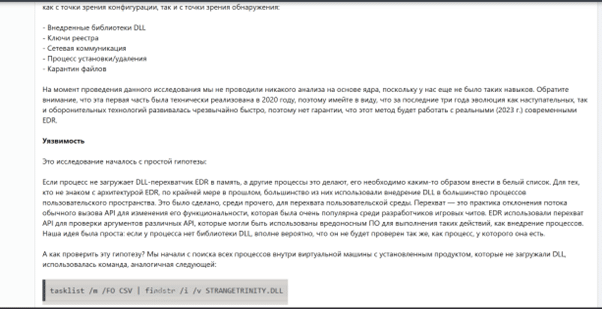
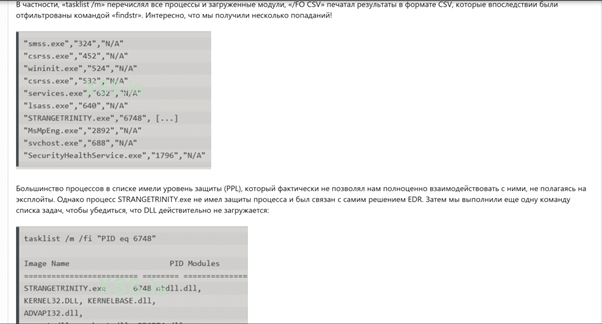
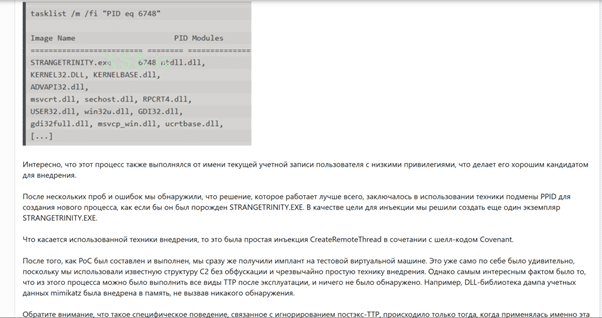
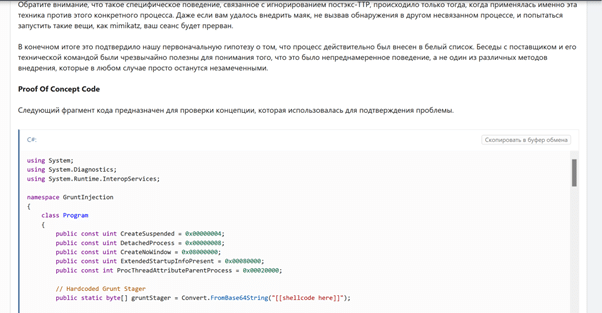
Figures 5-9. Yashechka posts: Attacks on EDR solutions
Explanation of malicious intent:
- EDR Solutions: These are security tools designed to detect, investigate and respond to threats on host computers and networks. They are critical for modern cybersecurity defenses. Research into bypassing or exploiting EDR solutions can be used maliciously to undermine these defenses.
- Vulnerability Exploitation: Yashechka’s posts outline practical research into exploiting vulnerabilities in EDR solutions. This includes bypass techniques that cybercriminals could potentially use to evade detection while carrying out malicious activities.
- Black Box Analysis: The approach described involves black box analysis—testing the systems without access to the source code or architecture. This is a common practice in both legitimate security research and malicious hacking attempts. This type of analysis can uncover vulnerabilities that might be exploited by attackers to disable or bypass EDR solutions.
- Collaboration with Vendor: While the vendor collaboration for a controlled testing environment is a positive aspect, it also indicates that certain vulnerabilities might have been found and potentially exploited during the research. If such vulnerabilities were disclosed improperly or not efficiently mitigated, they could pose serious risks to all users of the affected EDR solution.
- Ethical and Legal Implications Risks: Yashechka treads a fine line between ethical security concerns and activities that might be construed as unauthorized or illegal hacking, depending on the methods used.
In summary, the overall threat lies in the potential misuse of discovered vulnerabilities by attackers before vendors can quickly identify and address them.
Additionally, the detailed publication of exploited techniques without proper context or security measures can be leveraged by threat actors with malicious intent.
Conclusion
If Yashechka continues his active involvement across a wide variety of hacking forums and communities, organizations will have to ramp up their security measures beyond traditional EDRs. While Yashechka has been profiled within this blog, there are many others potentially actively carrying out attacks that might leverage Yashechka’s vast expertise to bypass or exploit EDR solutions and other point products for malicious intent or financial gain










